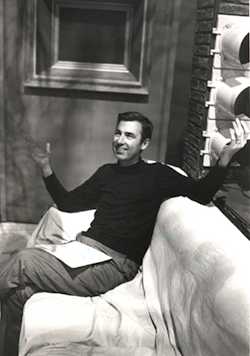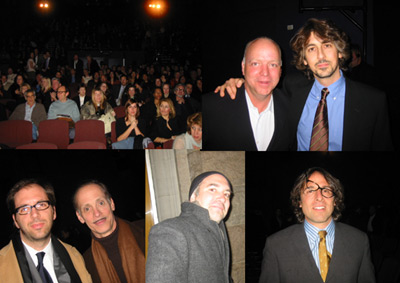
Alte Pinakothek, Selftportrait, Munich, 2000, Thomas Struth
The other night, I heard the photographer Thomas Struth talk about his work. A friend (who has a far more serious art habit than even I do) hosted a reception for the artist in his office. Extra Struths, brought out of storage for the evening, rested on stacks of printer paper, an installation technique you don't see at the artist's current one-man show at the Met.
Struth spoke very quietly, but determinedly, about his work and the ideas and process behind it. He's clearly contemplative, and some of his most well-known works are unabashedly about contemplation (his Paradise junglescapes and his photos of museumgoers). He described his decades-long relationship with the 1500 self-portrait of Albrecht Durer (above) and his fascination with its unusual gaze. By putting himself in the photo (that's Struth's shoulder), he wanted to capture a moment of a conversation, while readily allowing that the two figures may not be saying anything to each other.
He caught me off guard, though, by referring to the photo's cinematic character; but sure enough, the framing, blocking and "sightlines" are from one half of a shot/reverse-shot, the continuity editing staple for depicting a two-person conversation. Struth wanted to portray a conversation that crosses 500 years (he shot it in 2000), a long-term perspective Struth finds shamefully absent today.
"No one [in the current political situation] looks forward even 50 years; they only look to their next election." Struth then ruminated on art worlders and what they could do to pull the real world back from the brink of war. "We're here, in the office of [one of the wealthiest men in the world], there are so many influential people in the art world. Why don't people use this powerful social network" to avert this global disaster?
Nervous silence, nervous chatter, and then a spurt of panged/defensive hands, as a few people tried to explain how our "standing here sipping champagne" was actually alright. An older guy with a Palm Beach tan leaned over and murmured to me, "I think we're going in the wrong direction." "That's exactly what he's talking about," I deadpanned, "Oh, you mean the conversation." Soon, we returned, quickly, safely, and completely, to discussions of how, exactly, he was able to get that amazing shot of the Parthenon. ("Because I've tried to shoot it every time I go, and it's just so dark!")
One implication in Struth's photo, which cannot be avoided, of course, is our own responsibility. Shot/reverse-shot technique uses two components to establish the shared space; a reverse shot is needed. It would be a shot of Struth (and all of us, in the present day, standing in museums and galleries and private collections) from the perspective of Durer's painted space, maybe over the 16th-century artist's shoulder, a shot looking far into the future.



 Cremaster 2 Patch, click to order at the Gugg store
Cremaster 2 Patch, click to order at the Gugg store
 "When I snap my fingers, the box office will magically increase... image:guardian.co.uk
"When I snap my fingers, the box office will magically increase... image:guardian.co.uk And (according to the
And (according to the 




 Shipping container used in an illegal Israeli outpost, image:nytimes.com
Shipping container used in an illegal Israeli outpost, image:nytimes.com Shipping container used in an illegal Israeli outpost in the Jordan Valley, image:metropolismag.com
Shipping container used in an illegal Israeli outpost in the Jordan Valley, image:metropolismag.com


 shot
shot





 Sure, Gest's demands that VH1 put up his LA stylist in a nearby apartment for the scheduled duration of the shoot (6 months: $60K), that a VH1 staffer "stick her head inside the oven" to see if it's clean enough to shoot, and his refusals to appear when "he wasn't looking his personal best" get the media attention. But all VH1's real dealbreakers--the hours- and days-long delays getting into the couple's apartment; abruptly imposed shooting limits (from 30 shooting days per 10 episode cycle to 10 days per year [italics in original]); and constraints on their crew (restricted numbers, limited drilling/installation of equipment, etc.) can be traced back to the co-op board. Or more specifically, to Gest's failure to get the co-op board on board before signing the deal with VH1. How is this possible?
Sure, Gest's demands that VH1 put up his LA stylist in a nearby apartment for the scheduled duration of the shoot (6 months: $60K), that a VH1 staffer "stick her head inside the oven" to see if it's clean enough to shoot, and his refusals to appear when "he wasn't looking his personal best" get the media attention. But all VH1's real dealbreakers--the hours- and days-long delays getting into the couple's apartment; abruptly imposed shooting limits (from 30 shooting days per 10 episode cycle to 10 days per year [italics in original]); and constraints on their crew (restricted numbers, limited drilling/installation of equipment, etc.) can be traced back to the co-op board. Or more specifically, to Gest's failure to get the co-op board on board before signing the deal with VH1. How is this possible?







 Not Afraid of Love, 2000, Maurizio Cattelan, image: artnet.com
Not Afraid of Love, 2000, Maurizio Cattelan, image: artnet.com Carson Headroom, image:ap/nytimes.com
Carson Headroom, image:ap/nytimes.com










